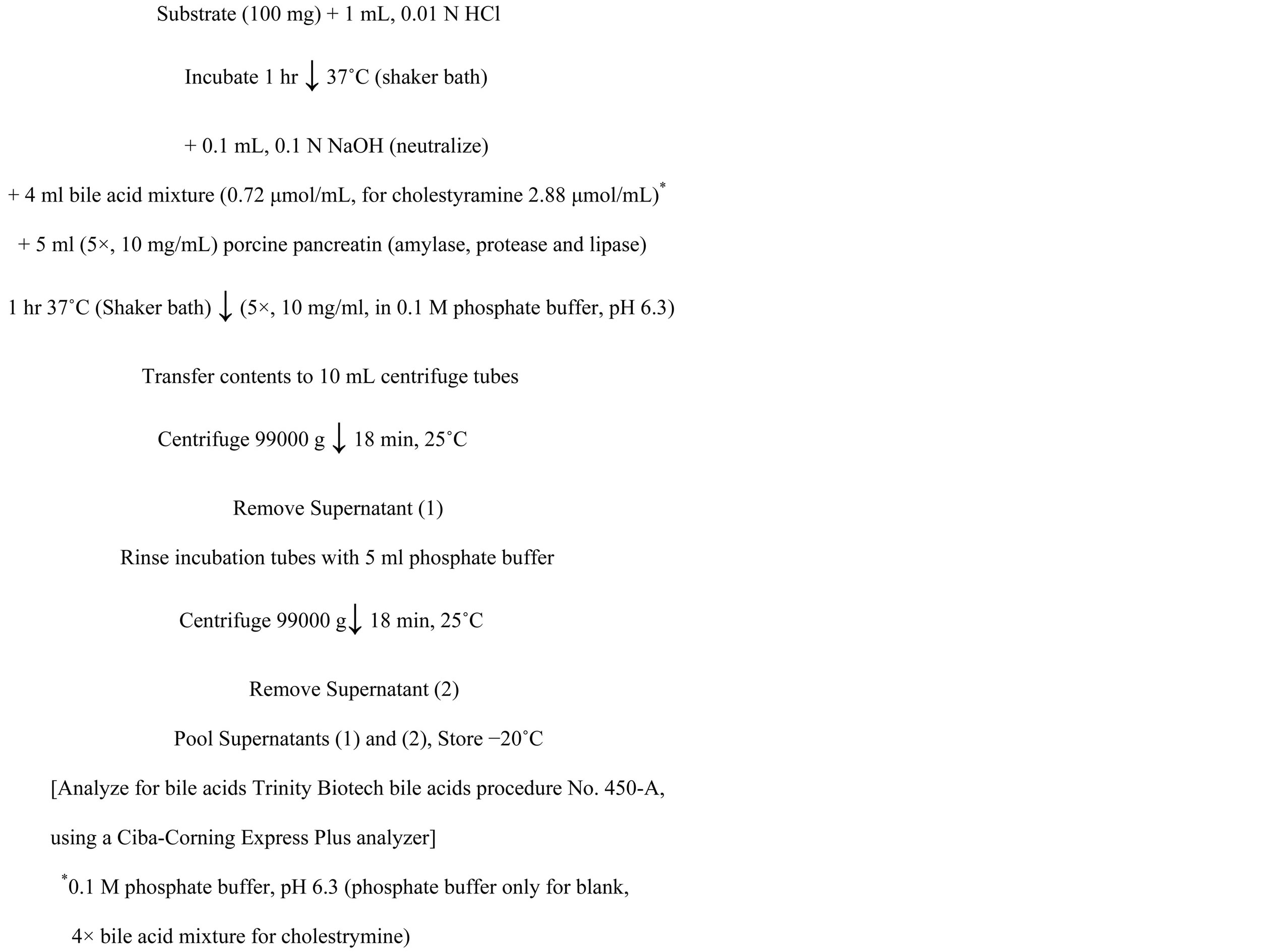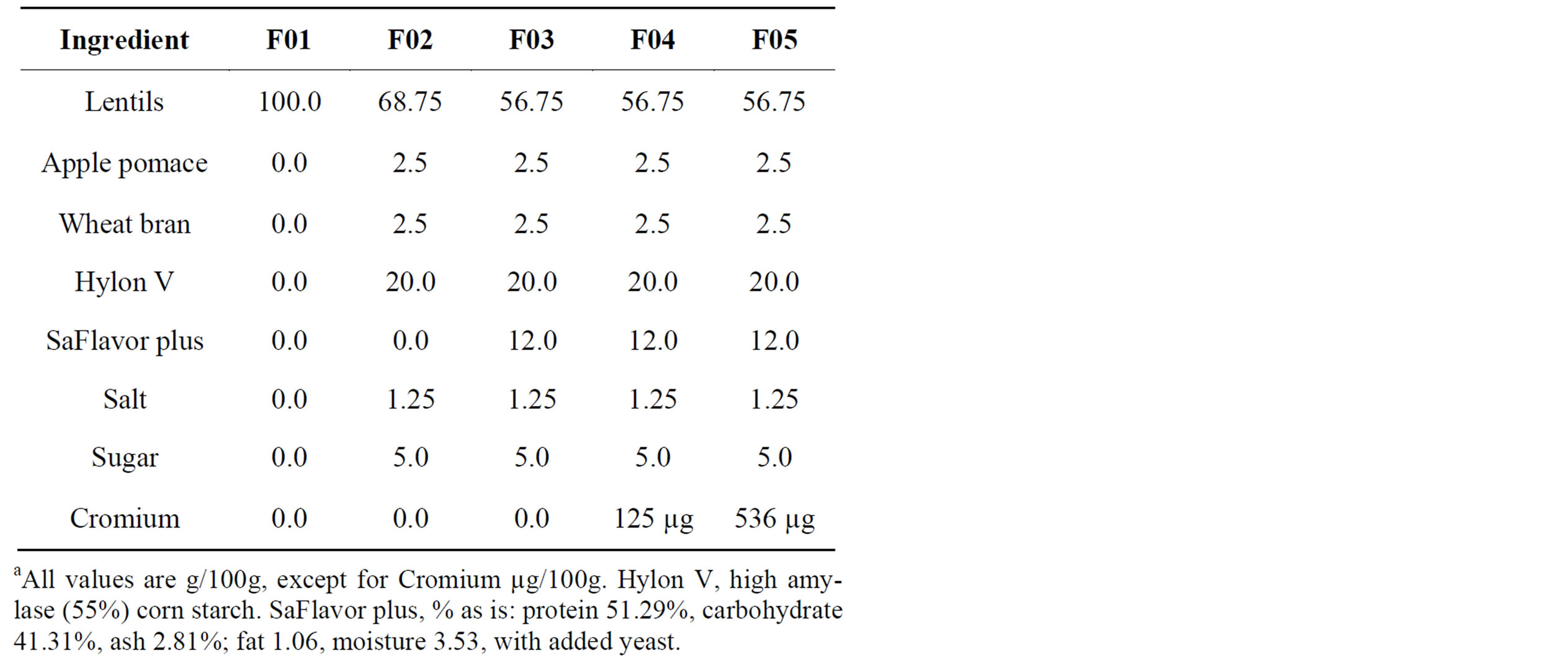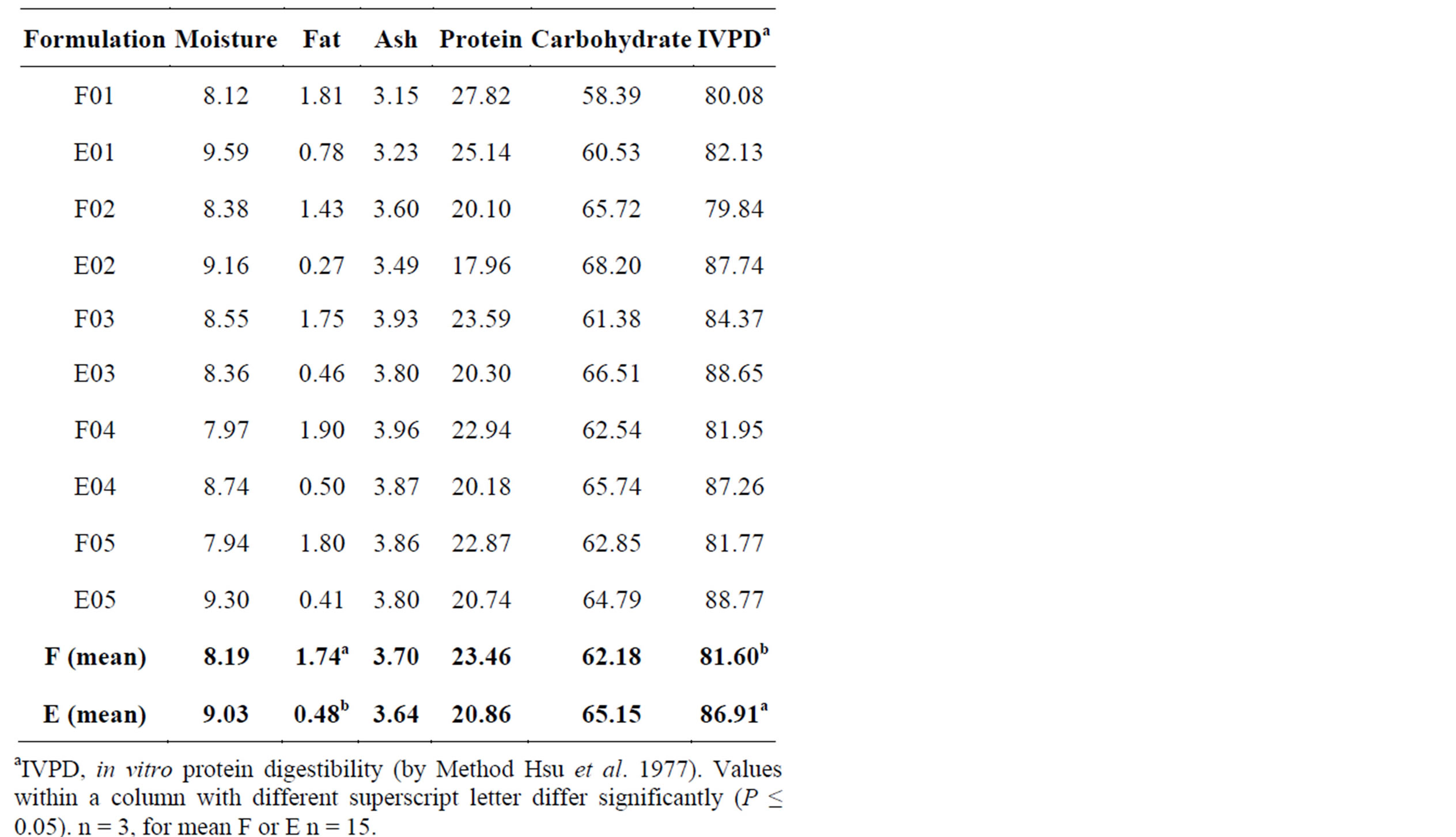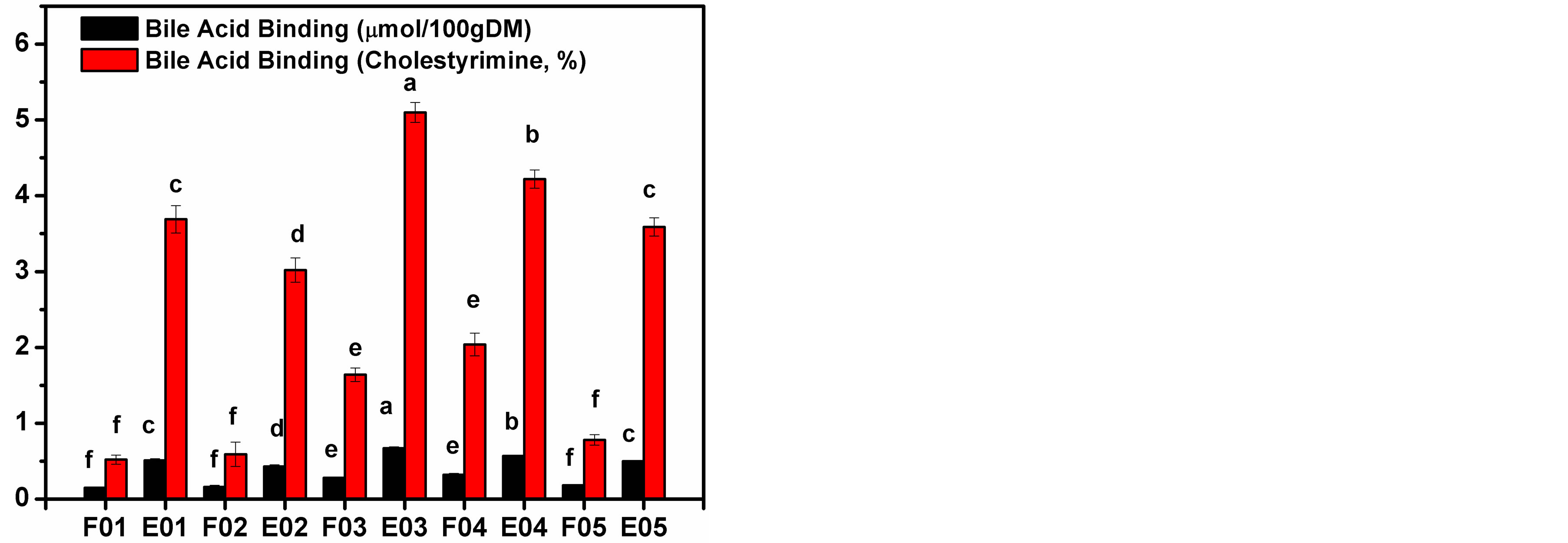Food and Nutrition Sciences
Vol.5 No.4(2014), Article ID:42735,5 pages DOI:10.4236/fns.2014.54043
Relative Bile Acid Binding Potential of Extruded Lentil Snacks
Western Regional Research Center, USDA-ARS*, Albany, USA.
Email: Talwinder.Kahlon@ars.usda.gov
Copyright © 2014 Talwinder Singh Kahlon et al. This is an open access article distributed under the Creative Commons Attribution License, which permits unrestricted use, distribution, and reproduction in any medium, provided the original work is properly cited. In accordance of the Creative Commons Attribution License all Copyrights © 2014 are reserved for SCIRP and the owner of the intellectual property Talwinder Singh Kahlon et al. All Copyright © 2014 are guarded by law and by SCIRP as a guardian.
Received June 25th, 2013; revised July 26th, 2013; accepted August 6th, 2013
KEYWORDS: Lentils; Raw Formulations; Extruded Snacks; Bile Acid Binding
ABSTRACT
Previously we have reported that extrusion significantly improved healthful potential of cereals. It was hypothesized that snacks produced by extrusion would be more healthful than their raw formulations. Bile acid binding has been reported to indicate cholesterol lowering and cancer risk reduction potential of food and fractions. Bile acid binding potential of five lentil snack raw formulations and their extruded snacks were evaluated. The raw formulations were 100% lentils (F01), 69% lentils (F02), 57% lentils + 12% supplement (F03), F03 with 125 µg/100g Chromium (F04), F03 with 536 µg/100g Chromium (F05), and their respective extruded (E) snacks E01, E02, E03, E04 and E05. The in vitro bile acid binding on an equal dry matter basis relative to cholestyramine, was F01 (0.5%), E01 (3.7%), F02 (0.6%), E02 (3.0%), F03 (1.6%), E03 (5.1%), F04 (2.0%), E04 (4.2%), F05 (0.8%) and E05 (3.6%). Replacing 12% lentils with high protein supplements (F02 vs. F03) resulted in significantly higher bile acid binding, suggesting that the supplement appears to have higher bile acid binding capacity than that of lentils. All the extruded lentil snacks had significantly higher bile acid binding compared with their raw formulations. Extruding with added chromium containing yeast resulted in significantly lower bile acid binding in a dose dependent manner. Most healthful lentil snacks were produced with the addition of high protein supplement without added chromium-containing yeast (E03). Data proved the hypothesis that lentil snacks produced by extrusion are significantly more healthful than their raw formulations.
1. Introduction
Atherosclerosis and cancer are the two leading causes of death and disability in the developed world and are increasing rapidly in the developing world [1]. These are the major human nutrition problems and are preventable with diet and physically active lifestyle. The healthful, cholesterol-lowering (atherosclerosis amelioration) potential of food fractions could be predicted by evaluating their in vitro bile acid binding, based on positive correlations found between in vitro and in vivo studies showing that cholestyramine (bile acid-binding, cholesterol-lowering drug) binds bile acids and cellulose does not [2-5]. Bile acids are acidic steroids synthesized in the liver from cholesterol. After conjugation with glycine or taurine, bile acids are secreted into the duodenum. Bile acids are actively reabsorbed by the terminal ileum and undergo an enterohepatic circulation [6]. Bile acids are needed for fat absorption and high fat diets are implicated in obesity as well as in raising plasma cholesterol. In response to lowered bile acid levels liver uses cholesterol to synthesize additional bile acids. Excreting bile acids is the major route for removal of cholesterol from the body [7]. Binding of bile acids and increasing their fecal excretion have been hypothesized as a possible mechanism by which food fractions lower cholesterol [8-10]. Secondary bile acids are known to be carcinogenic [11].
Cholesterol lowering and cancer risk reduction potential of food fractions could be evaluated by their bile acid binding capacity. In vitro bile acid binding without the use of labeled isotopes is an economical method for screening various foods and food fractions to evaluate their healthful potential before initiating time and cost intensive animal and human studies. Some international plant breeding companies have been using in vitro bile acid binding procedure [12] in their seed selections to propagate more health promoting crops. Extruded wheat bran and other foods have been shown to lower blood cholesterol in humans [13]. Extruded wheat bran at low specific mechanical energy (SME) of 120 - 221 Wh/kg, has been reported to significantly lower plasma and liver lipids in hamsters compared with unextruded wheat bran [14,15]. Previously it has been observed that in vitro bile acid binding of wheat bran extruded at 120 and 177 Wh/kg SME was significantly higher than un-extruded wheat bran [16]. It was hypothesized that snacks produced by extrusion would be more cholesterol-lowering compared with their raw formulations, as determined by their bile acid binding potential. In the study reported herein five lentil raw formulations and their extruded snacks were evaluated for their healthful potential by determining their in vitro bile acid binding relative to cholestyramine.
2. Methods and Materials
2.1. Bile Acid Binding Procedure
Kritchevsky and Story [17] have described in vitro bile acid binding procedure where labeled isotopes of bile acids were used. The in vitro bile acid binding procedure described here does not use labeled isotopes, thus eliminates the radiation hazards and disposal costs of the isotopes. The in vitro bile acid binding procedure for food fractions has been established by Kahlon and Chow [12] and further fine-tuned by Kahlon and Woodruff [18,19].
The stock bile acid mixture was formulated with glycocholic bile acids providing 75% and taurine-conjugated bile acids 25% of the bile acids based on the composition of the human bile [20,21]. This stock solution contained glycocholic acid (9 mmol/L), glycochenocholic acid (9 mmol/L), glycodeoxycholic acid (9 mmol/L), taurocholic acid (3 mmol/L), taurochenocholic acid (3 mmol/L) and taurodeoxycholic acid (3 mmol/L) in pH 6.3, 0.1 M phosphate buffer. A stock solution of 36 mmol/L was stored in a freezer maintained at −20˚C. Prior to each assay, working solution 0.72 or 2.88 μmol/mL was prepared from the stock solution, for test samples or cholestyramine, respectively. Cellulose, a non-bile acid binding fiber, was the negative control and cholestyramine, a bile acid binding anionic resin, was the positive control. Cholestyramine is a drug that lowers cholesterol by binding bile acids. Eight replicate incubations, consisting of six substrates with bile acid mixture, one substrate blank without bile acid mixture and one bile acid mixture without the substrate, were run for each of the ten treatments and two controls. The treatment replicates were weighed into 16 × 150 mm glass, screwcapped tubes. Diagram of the bile acid binding procedure is given in Figure 1. Each supernatant sample was analyzed in triplicate for unbound bile acids. Values were determined from a standard curve obtained by analyzing Trinity Biotech bile acid calibrators (No. 450-11) at 5, 25, 50, 100 and 200 μmol/L. Individual blank substrates were subtracted, and bile acid concentrations were corrected based on the mean recoveries of bile acid mixture (positive blank).
2.2. Lentil Snack Formulations
Lentil flour was purchased from a local wholesale distributor. Composition of lentil snack formulations is given in Table 1. The raw formulations and their extruded snacks were milled using 0.5 mm screen in a Cyclone mill (Udy Corp., Fort Collins, CO., USA), and stored in air-tight glass jars at room temperature for further analysis.

Figure 1. Diagram of the bile acid binding procedure.

Table 1. Composition of lentils snack raw formulations, % (as is)a.
2.3. Extrusion Conditions
A twin-screw extruder with co-rotating, inter-meshing screws, six barrel sections (128 mm each), screw diameter 32 mm, L/D ratio 24 and 50 kg feed/h (Clextral EVOL HT32-H) was used. The last barrel section and die temperature was maintained at 160˚C ± 1˚C. Screws were driven by a 74.8 kW variable speed drive, Model ACS600 (ABB Automation Inc., New Berlin, WI, USA). The screw speed was maintained constant at 500 rpm. A combination of feeding, transporting, compression, and kneading elements was used to provide a moderate shear screw configuration. The mixture was metered into the feed port by a twin-screw, loss-in-weight gravimetric feeder, Model LWFD5-20 (K-Tron Corp., Pitman, NJ, USA) at a rate of 25 kg/h (wwb). Water was supplied to the extruder by a triplex variable stroke piston pump with 12 mm plungers, Type VE-P33 (Bran and Luebbe, Wheeling, IL, USA) to provide a final moisture content of 17%. The lentil snack formulations were extruded through two circular dies each with 3.5 mm diameter openings. Pressure at the die was determined using a pressure transducer, Type PT412-5M (Dynisco Instruments, Sharon, MA, USA). A PLC+ Industrial computer (Allen-Bradley, Milwaukee, WI, USA) using Intouch software FITSYS PLUS ver. 1.23 was used to collect extruder parameter data at 1 s intervals for a total of 5 min. Data were collected approximately 10 min after the operation conditions of torque and pressure were at steady state.
2.4. Statistical Analysis
Data are presented as means ± SEM. Before accepting analysis of variance results, Lavene’s test was used to check for homogeneity of variances among treatments. Since variances were considered homogenous from test results, analysis of variance was used to test for significant differences among treatments. Dunnett’s one-tailed test was computed with treatments compared to cholestyramine as a positive control and compared to cellulose as a negative control. For comparing non-control treatments to each other, Tukey’s test for comparison of all possible pairs of means was used. A value of P ≤ 0.05 was considered the criterion of significance.
3. Results and Discussion
Extruding lentil snack formulations resulted in significant reduction in fat content, non-significant reduction in protein content, protein in the extruded snacks had significantly higher digestibility (Table 2). Cholestyramine resulted in significantly higher bile acid binding and cellulose significantly lower values than raw and extruded snack formulations tested. Cholestyramine resulted in 98% bile acid binding. This is consistent with previously reported observations and same physiological conditions [12,18,19]. Extruded lentil snacks resulted in significantly higher bile acid binding (0.43 - 0.67 µmol/100g DM) compared with their raw formulations (0.15 - 0.32 µmol/100g DM) Figure 2. Data suggest that extrusion would improve cholesterol-lowering (healthful potential) of all the snack formulations tested.
The mean binding value of cellulose (negative control) was deducted from all treatments and the positive control values. Assigning a bile acid binding value of 100% to cholestyramine, the relative bile acid binding values on a dry matter basis for the raw formulations values ranged from 0.52% - 2.04%, and for extruded snacks values ranged from 3.02% - 5.1% (Figure 2). Bile acid binding values for F03 (57% lentils and 12% SaFlavor) and F04 (F03 + 125 ug cromium) were significantly higher than those for F01, F02 and F05. Data suggest that replacing high amylase corn with SaFlavor with or without low level of cromium resulted in significant increase in health promoting potential. Relative bile acid binding significantly improved with extrusion for all the formulations tested compared with raw formulations (3.02 - 5.10 vs. 0.52% - 2.04% of cholestyramine). The highest relative bile acid binding values (5.10%) were for extruded snacks formulation E03 (57% lentils and 12% Saflavor). A relative bile acid binding value of 5% - 9% on dry matter basis for oat bran, oat bran ready to eat cereals and barley fractions (cereals with US-FDA and UK-Joint Health Claim initiative) approved for a label health claim for lowering cholesterol have been reported [22,23]. Data suggest that extruded snack E03 has the potential to qualify for the label US-FDA and UK-Joint Health Claims. Bile acid binding values for E03 were significantly higher that all other extruded snacks tested. Data suggest that E03 snack had the most health promoting potential. Rel-

Table 2. Proximate analysis of raw formulation (F) and extruded (E) snacks, % as is.

Figure 2. In vitro bile acid binding of lentil snack raw formulation (F01-05) and extruded formulations (E01-05); F01, 100% Lentils; E01, extruded F01, 128 WH/kg; F02, 69% Lentils, 0% SF; E02, extruded F02, 155 WH/kg; F03, 57% Lentils, 12% SF; E03, extruded F03, 145 WH/kg; F04, F03 + 125 µg Cr; E04, extruded F04, 140 WH/kg; F05, F03 + 536 µg Cr; E05, extruded F05, 140 WH/kg. Graph bars within µmol/100g DM or Cholestyramine %; that do not share a common superscript differ significantly (P ≤ 0.05), n = 6. SF (Safalvor Plus), balance of the ingredients for each formulation are given in Table 1.
ative healthful potential of extruded lentil snacks were E03 > E04 > E01 = E05 > E02. Extruded lentil snacks with added chromium E04 (4.2%) and E05 (3.6%) with (125 and 536 µg chromium/100g, respectively) resulted in lower bile acid binding in a dose dependent manner. Significantly lower bile acid binding values were observed when 31% lentils were replaced with 20% high amylase corn and other ingredients (E01 vs. E02). These results suggest that added ingredients had lower healthful potential than lentils.
4. Conclusion
The study proved the hypothesis that lentil snacks produced by extrusion have higher cholesterol-lowering (health promoting) potential relative to their raw formulations. High protein Saflavor plus appeared to have higher health promoting potential than lentils. Adding cromium to E03 formulation resulted in lowered healthful potential in a dose dependent manner. The extruded formulation E03 was most desirable to promote human nutrition and health.
5. Future Considerations
Evaluating other pulses in addition to lentils in the extruded snack formulations would be warranted. Supplementing lentil and other legume snacks with additional levels of Safalvor plus or similar high protein supplements to obtain the maximum healthful effects needs to evaluated.
REFERENCES
- C. D. Mathers, A. D. Lopez and C. J. L. Murray, “The Burden of Disease and Mortality by Condition: Data, Methods, and Results for 2001,” In: A. D. Lopez, C. D. Mathers, M. Ezzati, D. T. Jamison and C. J. L. Murray, Eds., Global Burden of Disease and Risk Factors, Oxford University Press, New York.
- K. E. Suckling, G. M. Benson, B. Bond, A. Gee, A. Glen, C. Haynes, et al., “Cholesterol Lowering and Bile Acid Excretion in the Hamster with Cholestyramine Treatment,” Atherosclerosis, Vol. 89, No. 2, 1991, pp. 183-190. http://dx.doi.org/10.1016/0021-9150(91)90059-C
- T. Nakamura and Y. Matsuzawa, “Drug Treatment of Hyperlipoproteinemia: Bile Acid-Binding Resins,” Nippon Rinsho, Vol. 52, No. 12, 1994, pp. 3266-3270.
- B. P. Daggy, N. C. O’Connell, G. R. Jerdack, B. A. Stinson and K. D. Setchell, “Additive Hypocholesterolemic Effect of Psyllium and Cholestyramine in the Hamster: Influence on Fecal Sterol and Bile Acid Profiles,” Journal of Lipid Research, Vol. 38, No. 3, 1997, pp. 491-502.
- T. S. Kahlon and F. I. Chow, “In Vitro Binding of Bile Acids by Rice Bran, Oat Bran, Wheat Bran and Corn Bran,” Cereal Chemistry, Vol. 77, No. 4, 2000, pp. 518- 521. http://dx.doi.org/10.1094/CCHEM.2000.77.4.518
- A. F. Hofmann, “The Enterohepatic Circulation of Bile Acids in Man,” Clinics in Gastroenterology, Vol. 6, No. 1, 1977, pp. 3-24.
- J. Hageman, H. Herrema, A. K. Groen and F. Kuipers, “A Role of Bile Salt Receptor FXR in Atherosclerosis,” Arteriosclerosis, Thrombosis, and Vascular Biology, Vol. 30, 2010, pp. 1519-1528. http://dx.doi.org/10.1161/ATVBAHA.109.197897
- H. C. Trowell, “Refined Foods and Disease,” Academic Press, London, 1975, pp. 195-226.
- E. K. Lund, J. M. Gee, J. C. Brown, P. J. Wood and I. T. Johnson, “Effect of Oat Gum on the Physical Properties of the Gastrointestinal Contents and on the Uptake of D-Galactose and Cholesterol by Rat Small Intestine in Vitro,” British Journal of Nutrition, Vol. 62, No. 1, 1989, pp. 91-101. http://dx.doi.org/10.1079/BJN19890010
- J. W. Anderson and A. E. Siesel, “Hypocholesterolemic Effects of Oat Products,” In: I. Furda, C. J. Brine, Eds., New Developments in Dietary Fiber: Physiological, Physiochemical, and Analytical Aspects, Plenum Press, New York, 1990, pp. 17-36. http://dx.doi.org/10.1007/978-1-4684-5784-1_3
- V. Costarelli, T. J. Key, P. N. Appleby, D. S. Allen, I. S. Fentiman and T. A. Sanders, “A Prospective Study of Serum Bile Acid Concentrations and Colorectal Cancer Risk in Post-Menopausal Women on the Island of Guernsey,” British Journal of Cancer, Vol. 86, 2002, pp. 1741- 1744. http://dx.doi.org/10.1038/sj.bjc.6600340
- T. S. Kahlon and F. I. Chow, “In Vitro Binding of Bile Acids by Riceran, Oat Bran, Wheat Bran, and Corn Bran,” Cereal Chemistry, Vol. 77, No. 4, 2000, pp. 518-521. http://dx.doi.org/10.1094/CCHEM.2000.77.4.518
- V. A. Meshcheriakova, O. A. Plotnikova, T. A. Iatsyshina, Kh. Kh. Sharafetdinov, M. L. Faivishevskii and T. N. Lisina, “New Extrusion Products in Diet Therapy of Diseases of Internal Organs,” Voprosy Pitaniia, Vol. 5, 1995, pp. 31-33.
- T. S. Kahlon, R. H. Edwards and F. I. Chow, “Effect of Extrusion on Hypocholesterolemic Properties of Rice, Oat, Corn, and Wheat Bran Diets in Hamsters,” Cereal Chemistry, Vol. 75, No. 6, 1998, pp. 897-903. http://dx.doi.org/10.1094/CCHEM.1998.75.6.897
- T. S. Kahlon, J. De J. Berrios, G. E. Smith and J. L. Pan, “Evaluating Hypocholesterolemic Properties of Extruded Wheat Bran Diets in Hamsters,” Cereal Chemistry, Vol. 83, No. 2, 2006, pp. 152-156. http://dx.doi.org/10.1094/CC-83-0152
- T. S. Kahlon, J. De J. Berrios, G. E. Smith and J. L. Pan, “In Vitro Bile Acid Binding Capacity of Wheat Bran Extruded at Five Specific Mechanical Energy Levels,” Cereal Chemistry, Vol. 83, No. 2, 2006, pp. 157-160. http://dx.doi.org/10.1094/CC-83-0157
- D. Kritchevsky and J. A. Story, “Binding of Bile Salts in Vitro by Nonnutritive Fiber,” Journal of Nutrition, Vol. 104, No. 4, 1974, pp. 458-462.
- T. S. Kahlon and C. L. Woodruff, “In Vitro Binding of Bile Acids by Rice Bran, Oat Bran, Barley and b-Glucan Enriched Barley,” Cereal Chemistry, Vol. 80, No. 3, 2003, pp. 260-263. http://dx.doi.org/10.1094/CCHEM.2003.80.3.260
- T. S. Kahlon and C. L. Woodruff, “In Vitro Binding of Bile Acids by Various Ready to Eat Breakfast Cereals,” Cereal Foods World, Vol. 48, No. 2, 2003, pp. 73-75.
- M. C. Carey and D. M. Small, “The Characteristics of Mixed Micellar Solutions with Particular Reference to Bile,” American Journal of Medicine, Vol. 49, No. 5, 1970, pp. 590-608. http://dx.doi.org/10.1016/S0002-9343(70)80127-9
- S. S. Rossi, J. L. Converse and A. F. Hoffman, “High Pressure Liquid Chromatography Analysis of Conjugated Bile Acids in Human Bile: Simultaneous Resolution of Sulfated and Unsulfated Lithocholyl Amidates and the Common Conjugated Bile Acids,” Journal of Lipid Research, Vol. 28, No. 5, 1987, pp. 589-595.
- US Food and Drug Administration, “FDA Final Rule for Federal Labeling: Health Claims; Oats and Coronary Heart Disease,” Federal Register, Vol. 62, 1997, pp. 3584-3681.
- Joint Health Claims Initiative, “Final Report on Generic Health Claim for Oats and Reduction of Blood Cholesterol,” 2004. http://webarchive.nationalarchives.gov.uk/nobanner/20130404135254/http://www.jhci.org.uk/approv/oats.htm
NOTES
*USDA is an equal opportunity provider and employer. Mention of trade names or commercial products in this report is solely for the purpose of providing specific information and does not imply recommendation or endorsement by the US Department of Agriculture.

